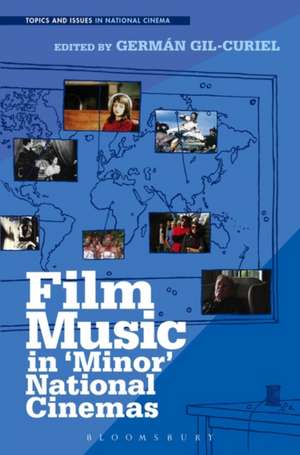Film Music in 'Minor' National Cinemas: Topics and Issues in National Cinema
Editat de Germán Gil-Curielen Limba Engleză Paperback – 23 aug 2017
| Toate formatele și edițiile | Preț | Express |
|---|---|---|
| Paperback (1) | 257.32 lei 6-8 săpt. | |
| Bloomsbury Publishing – 23 aug 2017 | 257.32 lei 6-8 săpt. | |
| Hardback (1) | 832.17 lei 6-8 săpt. | |
| Bloomsbury Publishing – 6 apr 2016 | 832.17 lei 6-8 săpt. |
Preț: 257.32 lei
Preț vechi: 295.30 lei
-13% Nou
Puncte Express: 386
Preț estimativ în valută:
49.24€ • 52.65$ • 41.05£
49.24€ • 52.65$ • 41.05£
Carte tipărită la comandă
Livrare economică 17 aprilie-01 mai
Preluare comenzi: 021 569.72.76
Specificații
ISBN-13: 9781501320224
ISBN-10: 150132022X
Pagini: 240
Ilustrații: 26 bw illus
Dimensiuni: 152 x 229 x 18 mm
Greutate: 0.35 kg
Ediția:NIPPOD
Editura: Bloomsbury Publishing
Colecția Bloomsbury Academic
Seria Topics and Issues in National Cinema
Locul publicării:New York, United States
ISBN-10: 150132022X
Pagini: 240
Ilustrații: 26 bw illus
Dimensiuni: 152 x 229 x 18 mm
Greutate: 0.35 kg
Ediția:NIPPOD
Editura: Bloomsbury Publishing
Colecția Bloomsbury Academic
Seria Topics and Issues in National Cinema
Locul publicării:New York, United States
Caracteristici
Summarizes the under-explored relationship between film music and cinema, using Deleuze's concept of minor cinema as a unifying thread
Notă biografică
Germán Gil-Curiel is Research Affiliate at University College Cork, Republic of Ireland, where he also teaches Latin American Music. An accomplished classical guitarist, his main research and teaching interests are on the relationship between music, film and literature. He is the author of A Comparative Approach: The Early European Supernatural Tale: Five Variations on a Theme (2011), and has published multiple book chapters and articles about music in film.
Cuprins
Chapter 1: Introduction: Film, Music & National Cinemas: Asia, Africa and Latin America Germán Gil-Curiel, Sino-British College, Shanghai, ChinaChapter 2: New Zealand Cinema, National Identity and Don McGlashanHenry Johnson, University of Otago, New Zealand Chapter 3: Chinese Identity and Total Art: Tan Dun's Aesthetics of Visual MusicGermán Gil-Curiel, Sino-British College, Shanghai, China Chapter 4: The China Melody: Musical Invention of Borderless Fantasy on Japan's Imperial ScreenChikako Nagayama, McMaster University, Canada Chapter 5: Collective Nostalgia and Anxiety in Korean Film Music: Im Kwont'aek's Use of P'ansori in Sop'yonjeJooyeon Rhee, Wittenberg University, USA Chapter 6: 'Sobre las Olas', the Waltz and the Films: Classical Music and Mexican IdentityArmida de la Garza, Xian-Jiaotong Liverpool University, China Chapter 7: Black Orpheus (1959) and Brazilian IdentityHans Hess, University of Bristol, UK Chapter 8: 'Yo soy un hombre sincero': Music and Nation-building in Cuban CinemaNicholas Balaisis, Concordia University, CanadaChapter 9: 'Minor' Sounds in Flight: Musical Journeys as Collective Oral Histories and Archival Sights and Sounds in the Films of Bahman GhobadiRowena Santos Aquino, California State University, Long Beach, USA Chapter 10: High and Low: Popular Music in Portuguese FilmCarolin Overhoff Ferreira, Federal University of São Paulo, Brazil Chapter 11: Between the Ceremonial and the Musical: Music and African Identity in the Films of Flora GomesCarolin Overhoff Ferreira, Federal University of São Paulo, Brazil Chapter 12: Between the Text and the Subtext: A Reading of Selected Benin Musical Video-Films from Nigeria Osakue S. Omoera, University of Ibadan, Nigeria, and Charles O. Aluede, Obafemi Awolowo University, NigeriaNotes on Contributors GlossaryIndex
Recenzii
Mentioned.
This book competently addresses two elements in need of further scholarly attention: non-mainstream cinema and film music. From Cuba to New Zealand, and from steampunk to samba, this collection is an eclectic mix of films and their soundtracks. The authors juggle advanced concepts from film theory with themes such as censorship, nostalgia, nationalism and many others to paint a complex relationship between more global mainstream trends and localized translations and innovations.
This book competently addresses two elements in need of further scholarly attention: non-mainstream cinema and film music. From Cuba to New Zealand, and from steampunk to samba, this collection is an eclectic mix of films and their soundtracks. The authors juggle advanced concepts from film theory with themes such as censorship, nostalgia, nationalism and many others to paint a complex relationship between more global mainstream trends and localized translations and innovations.









